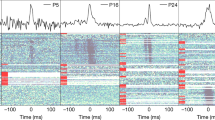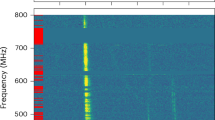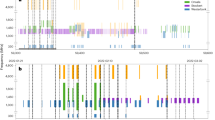Abstract
Fast radio bursts (FRBs) are a newly discovered class of extragalactic radio transients characterized by their high energy and short duration (from microseconds to milliseconds)1. The physical origin of these FRBs remains unknown and is a subject of ongoing research, with magnetars emerging as leading candidates2,3. Previous studies have used various methodologies to address the problem of FRB origin, including demographic analyses of FRB host galaxies and their local environments4,5,6, assessments of FRB rate evolution with redshift7,8,9 and searches for proposed multi-messenger FRB counterparts10. However, these studies are susceptible to substantial biases stemming from unaccounted radio and optical selection effects. Here we present empirical evidence for a substantial selection bias against detecting FRBs in galaxies with large inclination angles (edge-on) using a sample of hosts identified for FRBs discovered by untargeted surveys. This inclination-related bias probably leads to a significant underestimation (by about a factor of two) of the FRB rates reported in the literature and disfavours globular clusters as the dominant origin of FRB sources, as previously speculated6. These conclusions have important implications for FRB progenitor models and targeted FRB follow-up strategies. We further investigate the impact of this bias on the relative rate of FRBs in different host environments. Our analysis suggests that scattering in FRB hosts is probably responsible for the observed bias11,12. However, a larger sample of localized FRBs is required to robustly quantify the contribution of scattering to the inclination-related selection bias.
This is a preview of subscription content, access via your institution
Access options
Access Nature and 54 other Nature Portfolio journals
Get Nature+, our best-value online-access subscription
27,99 € / 30 days
cancel any time
Subscribe to this journal
Receive 51 print issues and online access
199,00 € per year
only 3,90 € per issue
Buy this article
- Purchase on SpringerLink
- Instant access to full article PDF
Prices may be subject to local taxes which are calculated during checkout


Similar content being viewed by others
Data availability
The data that support the plots in this paper and other findings of this study are available from the corresponding author upon reasonable request. The Pan-STARRS DR1, SDSS DR16 and DESI optical r-band imaging data used in this analysis can be accessed from the publicly available MAST SDSS Data Archive Server, MAST PS1 Science Archive Server and DESI Legacy Imaging Survey interface, respectively, or can be downloaded from GitHub (https://github.com/Astronomer-Mohit/Bhardwajetal_2024_nature_inclination_angle).
Code availability
The following software packages were used to analyse the data presented in this paper: APLpy69, astropy70, AutoProf19, Photutils20 and Scipy71. The codes used for data processing and producing the figures are available from GitHub (https://github.com/Astronomer-Mohit/Bhardwajetal_2024_nature_inclination_angle) or from the corresponding author upon reasonable request.
References
Lorimer, D. R., Bailes, M., McLaughlin, M. A., Narkevic, D. J. & Crawford, F. A bright millisecond radio burst of extragalactic origin. Science 318, 777–780 (2007).
The CHIME/FRB Collaboration. A bright millisecond-duration radio burst from a galactic magnetar. Nature 587, 54–58 (2020).
Bochenek, C. D. et al. A fast radio burst associated with a galactic magnetar. Nature 587, 59–62 (2020).
Li, Y. & Zhang, B. A comparative study of host galaxy properties between fast radio bursts and stellar transients. Astrophys. J. Lett. 899, L6 (2020).
Gordon, A. C. et al. The demographics, stellar populations, and star formation histories of fast radio burst host galaxies: implications for the progenitors. Astrophys. J. 954, 80 (2023).
Bhardwaj, M. et al. Host galaxies for four nearby CHIME/FRB sources and the local universe FRB host galaxy population. Astrophys. J. Lett. 971, L51 (2024).
Luo, R. et al. On the FRB luminosity function – II. Event rate density. Mon. Not. R. Astron. Soc. 494, 665–679 (2020).
Hashimoto, T. et al. No redshift evolution of non-repeating fast radio burst rates. Mon. Not. R. Astron. Soc. 498, 3927–3945 (2020).
Zhang, R. C., Zhang, B., Li, Y. & Lorimer, D. R. On the energy and redshift distributions of fast radio bursts. Mon. Not. R. Astron. Soc 501, 157–167 (2021).
Nicastro, L. et al. Multiwavelength observations of fast radio bursts. Universe 7, 76 (2021).
Chawla, P. et al. Modeling fast radio burst dispersion and scattering properties in the first CHIME/FRB catalog. Astrophys. J. 927, 35 (2022).
Ocker, S. K., Cordes, J. M., Chatterjee, S. & Gorsuch, M. R. Radio scattering horizons for galactic and extragalactic transients. Astrophys. J. 934, 71 (2022).
Aggarwal, K. et al. Probabilistic association of transients to their hosts (PATH). Astrophys. J. 911, 95 (2021).
Macquart, J.-P. et al. The Commensal Real-Time ASKAP Fast-Transients (CRAFT) survey. Publ. Astron. Soc. Aust. 27, 272–282 (2010).
Law, C. J. et al. Deep synoptic array science: first FRB and host galaxy catalog. Astrophys J. 967, 29 (2024).
The CHIME/FRB Collaboration. CHIME/FRB discovery of 25 repeating fast radio burst sources. Astrophys. J. 947, 83 (2023).
Chambers, K. C. et al. The Pan-STARRS1 surveys. Preprint at https://arxiv.org/abs/1612.05560 (2016).
DESI Collaboration. The DESI Experiment Part I: science, targeting, and survey design. Preprint at https://arxiv.org/abs/1611.00036 (2016).
Stone, C. J., Arora, N., Courteau, S. & Cuillandre, J.-C. AutoProf – I. An automated non-parametric light profile pipeline for modern galaxy surveys. Mon. Not. R. Astron. Soc. 508, 1870–1887 (2021).
Bradley, L. astropy/photutils: 1.8.0. Zenodo https://doi.org/10.5281/zenodo.7946442 (2023).
Yuan, F.-T., Lu, J., Shen, S. & Boquien, M. Asymmetry revisited: the effect of dust attenuation and galaxy inclination. Astrophys. J. 911, 145 (2021).
Chatterjee, S. et al. A direct localization of a fast radio burst and its host. Nature 541, 58–61 (2017).
Niu, C. H. et al. A repeating fast radio burst associated with a persistent radio source. Nature 606, 873–877 (2022).
Saadeh, D., Feeney, S. M., Pontzen, A., Peiris, H. V. & McEwen, J. D. How isotropic is the universe? Phys. Rev. Lett. 117, 131302 (2016).
Joachimi, B. et al. Galaxy alignments: an overview. Space Sci. Rev. 193, 1–65 (2015).
Ahumada, R. et al. The 16th data release of the Sloan Digital Sky Surveys: first release from the APOGEE-2 Southern Survey and full release of eBOSS spectra. Astrophys. J. Suppl. Ser. 249, 3 (2020).
Strateva, I. et al. Color separation of galaxy types in the Sloan Digital Sky Survey imaging data. Astron. J. 122, 1861–1874 (2001).
Scholz, F. W. & Stephens, M. A. K-sample anderson–darling tests. J. Am. Stat. Assoc. 82, 918–924 (1987).
Mann, H. B. & Whitney, D. R. On a test of whether one of two random variables is stochastically larger than the other. Ann. Math. Stat. 18, 50–60 (1947).
Ravi, V. The prevalence of repeating fast radio bursts. Nat. Astron. 3, 928–931 (2019).
Bhardwaj, M. et al. A local universe host for the repeating fast radio burst FRB 20181030A. Astrophys. J. Lett. 919, L24 (2021).
James, C. W. Modelling repetition in zDM: a single population of repeating fast radio bursts can explain CHIME data. Publ. Astron. Soc. Aust. 40, e057 (2023).
Pelliciari, D. et al. The Northern Cross Fast Radio Burst project. III. The FRB-magnetar connection in a sample of nearby galaxies. Astron. Astrophys. 674, A223 (2023).
Agarwal, D. et al. A fast radio burst in the direction of the Virgo Cluster. Mon. Not. R. Astron. Soc. 490, 1–8 (2019).
Mackey, A. D. & Gilmore, G. F. Comparing the properties of local globular cluster systems: implications for the formation of the Galactic halo. Mon. Not. R. Astron. Soc. 355, 504–534 (2004).
Bhardwaj, M. et al. A nearby repeating fast radio burst in the direction of M81. Astrophys. J. Lett. 910, L18 (2021).
Kirsten, F. et al. A repeating fast radio burst source in a globular cluster. Nature 602, 585–589 (2022).
Xu, J. & Han, J. L. Extragalactic dispersion measures of fast radio bursts. Res. Astron. Astrophys. 15, 1629–1638 (2015).
Cordes, J. M., Wharton, R. S., Spitler, L. G., Chatterjee, S. & Wasserman, I. Radio wave propagation and the provenance of fast radio bursts. Preprint at https://arxiv.org/abs/1605.05890 (2016).
Wada, K. & Norman, C. A. Density structure of the interstellar medium and the star formation rate in galactic disks. Astrophys. J. 660, 276–287 (2007).
Ejdetjärn, T., Agertz, O., Östlin, G., Renaud, F. & Romeo, A. B. From giant clumps to clouds - III. The connection between star formation and turbulence in the ISM. Mon. Not. R. Astron. Soc. 514, 480–496 (2022).
Salim, S. Green Valley Galaxies. Serb. Astron. J. 189, 1–14 (2014).
van den Bergh, S. & Tammann, G. A. Galactic and extragalactic supernova rates. Annu. Rev. Astron. Astrophys. 29, 363–407 (1991).
Brinchmann, J. et al. The physical properties of star-forming galaxies in the low-redshift Universe. Mon. Not. R. Astron. Soc. 351, 1151–1179 (2004).
The CHIME/FRB Collaboration. The first CHIME/FRB fast radio burst catalog. Astrophys. J. Suppl. Ser. 257, 59 (2021).
Lee-Waddell, K. et al. The host galaxy of FRB 20171020A revisited. Publ. Astron. Soc. Aust. 40, e029 (2023).
Ravi, V. et al. Deep Synoptic Array Science: discovery of the host galaxy of FRB 20220912A. Astrophys. J. Lett. 949, L3 (2023).
Cordes, J. M. & Lazio, T. J. W. NE2001.I. A new model for the galactic distribution of free electrons and its fluctuations. Preprint at https://arxiv.org/abs/astro-ph/0207156 (2002).
Macquart, J.-P. et al. A census of baryons in the Universe from localized fast radio bursts. Nature 581, 391–395 (2020).
Hubble, E. Extragalactic nebulae. Astrophys. J. 64, 321–369 (1926).
van den Bergh, S. Inclinations and axial ratios of spiral and irregular galaxies. Publ. Astron. Soc. Pac. 100, 344–345 (1988).
Unterborn, C. T. & Ryden, B. S. Inclination-dependent extinction effects in disk galaxies in the Sloan Digital Sky Survey. Astrophys. J. 687, 976–985 (2008).
Japelj, J. et al. Host galaxies of SNe Ic-BL with and without long gamma-ray bursts. Astron. Astrophys. 617, A105 (2018).
Sérsic, J. L. Influence of the atmospheric and instrumental dispersion on the brightness distribution in a galaxy. Bol. Asoc. Argent. Astron. 6, 41–43 (1963).
Jedrzejewski, R. I. CCD surface photometry of elliptical galaxies - I. Observations, reduction and results. Mon. Not. R. Astron. Soc. 226, 747–768 (1987).
Ciambur, B. C. Beyond ellipse(s): accurately modeling the isophotal structure of galaxies with ISOFIT and CMODEL. Astrophys. J. 810, 120 (2015).
Merryfield, M. et al. An injection system for the CHIME/FRB experiment. Astron. J. 165, 152 (2023).
Ibik, A. L. et al. Proposed host galaxies of repeating fast radio burst sources detected by CHIME/FRB. Astrophys. J. 961, 99 (2024).
Bannister, K. W. et al. A single fast radio burst localized to a massive galaxy at cosmological distance. Science 365, 565–570 (2019).
Day, C. K. et al. High time resolution and polarization properties of ASKAP-localized fast radio bursts. Mon. Not. R. Astron. Soc. 497, 3335–3350 (2020).
Qiu, H. et al. A population analysis of pulse broadening in ASKAP fast radio bursts. Mon. Not. R. Astron. Soc. 497, 1382–1390 (2020).
Bhandari, S. et al. Limits on precursor and afterglow radio emission from a fast radio burst in a star-forming galaxy. Astrophys. J. Lett. 901, L20 (2020).
Caleb, M. et al. A subarcsec localized fast radio burst with a significant host galaxy dispersion measure contribution. Mon. Not. R. Astron. Soc. 524, 2064–2077 (2023).
Connor, L. et al. Deep synoptic array science: two fast radio burst sources in massive galaxy clusters. Astrophys. J. Lett. 949, L26 (2023).
Zhang, Y.-K. et al. FAST observations of FRB 20220912A: burst properties and polarization characteristics. Astrophys. J. 955, 142 (2023).
Orr, M. E., Burkhart, B., Lu, W., Ponnada, S. B. & Hummels, C. B. Objects may be closer than they appear: significant host galaxy dispersion measures of fast radio bursts in zoom-in simulations. Preprint at https://arxiv.org/abs/2406.03523 (2024).
Anna-Thomas, R. et al. Magnetic field reversal in the turbulent environment around a repeating fast radio burst. Science 380, 599–603 (2023).
Ocker, S. K. et al. Scattering variability detected from the circumsource medium of FRB 20190520B. Mon. Not. R. Astron. Soc. 519, 821–830 (2023).
Foreman-Mackey, D., Hogg, D. W., Lang, D. & Goodman, J. mcee: the MCMC hammer. Publ. Astron. Soc. Pac. 125, 306–312 (2013).
The Astropy Collaboration. Astropy: a community Python package for astronomy. Astron. Astrophys. 558, A33 (2013).
Virtanen, P. et al. SciPy 1.0: fundamental algorithms for scientific computing in Python. Nat. Methods 17, 261–272 (2020).
Acknowledgements
We thank D. Lang for the discussions. We also thank C. Stone for assisting with the profile-fitting routines of AutoProf. This research used Photutils, an Astropy package for the detection and photometry of astronomical sources. M.B. is a McWilliams fellow and an International Astronomical Union Gruber fellow. M.B. receives support from the McWilliams seed grant.
Author information
Authors and Affiliations
Contributions
M.B. conceived the methodology and framework of this work. K.J. conducted the initial analysis for this project under the supervision of M.B. However, all the results presented in this work were refined by J.L. with the assistance of M.B. M.B. led the writing of this paper, with J.L. contributing to the Methods section.
Corresponding author
Ethics declarations
Competing interests
The authors declare no competing interests.
Peer review
Peer review information
Nature thanks James Cordes, Jason Hessels and Maura McLaughlin for their contribution to the peer review of this work.
Extended data figures and tables
Extended Data Fig. 1 Parametric profile fitting results for 23 FRB host galaxies using the AutoProf package.
For each galaxy, we show three images - (left) r-band image of the host, (center) best-fitted galaxy model, and (right) resultant residual. The numbers in the top left of each r-band image correspond to the host number and the estimated inclination angle (in degrees, quoted in parentheses), as shown in Table 1. The X-axis and Y-axis of all plots represent right ascension and declination, respectively.
Extended Data Fig. 2 Non-parametric profile fitting results for 23 FRB host galaxies using the Photutils package.
For each galaxy, we show three images - (left) r-band image of the host, (center) best-fitted galaxy model, and (right) resultant residual. The numbers in the top left of each r-band image correspond to the host number and the estimated inclination angle (in degrees, quoted in parentheses), as shown in Table 1. The X-axis and Y-axis of all plots represent right ascension and declination, respectively.
Extended Data Fig. 3 Histogram of Cosine of Inclination Angles for SDSS-DR16 Galaxies.
This histogram illustrates the distribution of cos(i) values for galaxies sampled from the SDSS-DR16 catalog, following the selection criteria described in the Methods section.
Extended Data Fig. 4 Comparison of Cosine of Inclination Angle (cos(i)) CDFs for SDSS Galaxies and FRB Hosts.
The top plot shows the mean \(\cos (i)\) CDF for randomly sampled SDSS galaxies, employing a methodology similar to that used for Fig. 1, albeit with variations in u − r color thresholds. Similarly, the bottom left plot illustrates the impact on the mean \(\cos (i)\) CDF of SDSS galaxies for different mr thresholds. Finally, the bottom right plot displays the \(\cos (i)\) CDF where SDSS galaxies are sampled in each iteration to match the mr distribution of our FRB host sample. The blue shaded region represents the 68% credible bound on the SDSS galaxy CDF to account for the small sample size. In all cases, the SDSS galaxy CDFs are found to be statistically different from the \(\cos (i)\) CDF of FRB hosts in our sample, depicted in red in all three plots.
Rights and permissions
Springer Nature or its licensor (e.g. a society or other partner) holds exclusive rights to this article under a publishing agreement with the author(s) or other rightsholder(s); author self-archiving of the accepted manuscript version of this article is solely governed by the terms of such publishing agreement and applicable law.
About this article
Cite this article
Bhardwaj, M., Lee, J. & Ji, K. Selection bias obfuscates the discovery of fast radio burst sources. Nature 634, 1065–1069 (2024). https://doi.org/10.1038/s41586-024-08065-w
Received:
Accepted:
Published:
Issue Date:
DOI: https://doi.org/10.1038/s41586-024-08065-w



